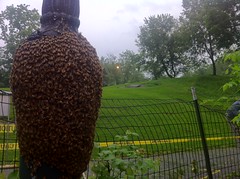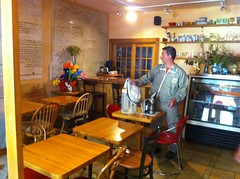Photos: Daniel Maurer
The Sixth Street Community Center got approximately 15,000 new tenants yesterday: about three and a half pounds of bees that may make honey for its café, opening next month. The hives on the community center’s rooftop are among many in the East Village, according to the beekeeper who brought the swarm down from Central Park.
On Wednesday (the same day he dealt with a mass of bees on the Bowery), Andrew Cote helped capture another swarm attached to a lamppost near Harlem Meer Lake, near 110th Street. He offered them up on the New York City Beekeepers Association’s Facebook page. Ray Sage, a member of the Sixth Street Community Center CSA who has tended to four hives on the former synagogue’s roof for the past three years, was the first to respond.
As Mr. Cote walked down Sixth Street on his way to the community center, he got shoutouts from residents impressed by his vaguely spacesuit-like uniform and face guards, or “veils,” similar to those used in fencing. “That’s cool, man,” said a man who spotted his mesh container of bees.
On the sun-soaked rooftop between Avenues B and C, he quickly dumped the bees out of the container (sans veil) and into a hive as if emptying a waste basket, sending dozens of them buzzing around him. The Central Park bees were now sharing a space with another colony, separated from their Alphabet City counterparts by a sheet of newspaper. Over the next two days, the bees would gradually work their way through the newspaper and blend together.
They would likely yield only a small amount of honey, said Mr. Sage. The Lower East Side resident’s hives are relatively new and he doesn’t get up to the roof to feed them sugar as often as he would like. He took about 20 pounds of nectar in the fall and expects to take another 10 in about a month. “I have to watch that they don’t get honey-bound,” he said. “If they fill all their cone with honey the queen can’t lay eggs and I want to keep her laying as much as possible to build honey.”
Mr. Sage said honey wasn’t his main objective when he first took beekeeping classes from Mr. Cote. “I was trying to encourage pollination, to bring pollinators into the area,” he said. “I wanted to help the population of bees grow. I felt so helpless watching the environment deteriorate.”
But the honey does go to use – he gave a few small jars to the Community Center, which may host tastings of it once its Organic Soul Café opens in June. The café will serve vegetarian and raw-food dishes as well as sustainable seafood three nights a week in conjunction with comedy, music, and other events in its back room.
Howard Brandstein, the executive director of the Community Center and a member of its CSA along with Mr. Sage, said the honey was a far cry from the commercial variety. “It’s awesome – a little more rounded than the stuff that comes out of the jar,” he said. “It’s a fuller taste and you’re chewing on some of the wax, too.”
Watching the beekeepers at work on the rooftop, Mr. Brandstein asked whether the East Village’s many community gardens meant an abundance of honey, and Mr. Cote said no. “There are a lot of hives in this area,” he explained, citing some on Fourth Street between C and D, Eighth Street between C and D, 10th Street and First Avenue, and on 11th Street as well. “They’re all competing for the same stuff. It takes one million flowers for bees to gather enough nectar to make a pound of honey, so they need a couple hundred each. So that’s billions of flowers. There aren’t that many flowers here.”
“There’s just a lot of people doing this now,” he said.






